Thursday, February 12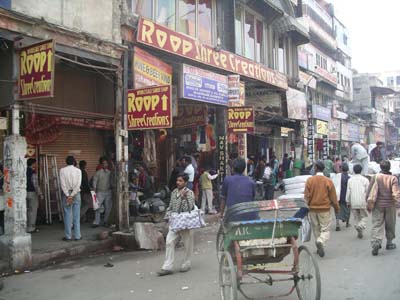
Steve: This was our day to explore Delhi, and we made
the most of it. Utpal picked us up this morning and we immediately headed
to Old Delhi. It was obvious when we left New Delhi and entered the old town
- amazingly, the streets became even more congested than what we had experienced
yesterday. Old Delhi is a bustling and very crowded commercial center, organized
by the products that are for sale along its narrow streets. Utpal told us
that there is a street for virtually anything we could imagine, including
greeting cards, silk, silver, automobile parts, etc. This reminded us somewhat
of the souqs in Morocco, but Old Delhi's streets are much livelier and somewhat
intimidating because of all the cars, rickshaws, bikes and scooters that speed
through the narrow passages. 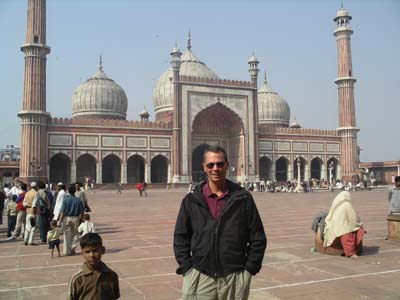
Before exploring the commercial district, we began at the mosque of Jama
Masjid, the largest mosque in India. The population of India is 12% Moslem,
and the Jama Masid is their most important place of worship. It was built
by Sh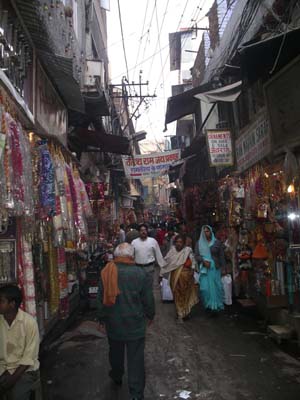 ah
Jahan, who was also the architect of the Taj Mahal. Unlike the mosques we
visited in Istanbul and Morocco, the Jama Masjid is all outside, with a large
area that is used for prayers 5 times each day.
ah
Jahan, who was also the architect of the Taj Mahal. Unlike the mosques we
visited in Istanbul and Morocco, the Jama Masjid is all outside, with a large
area that is used for prayers 5 times each day.
Next we took a tour through the streets of Old Delhi. The variety of people,
transportation methods, foods and products for sale is amazing. Today's experience
was even more eye-opening than when we walked through the medina in Marrakech.
The noises, smells, crowds, trash and traffic are absolutely overwhelming.
At times, it was hard not to be intimidated, and it was especially difficult
to walk on the streets with rickshaws and other vehicles (motorized and non-motorized)
cons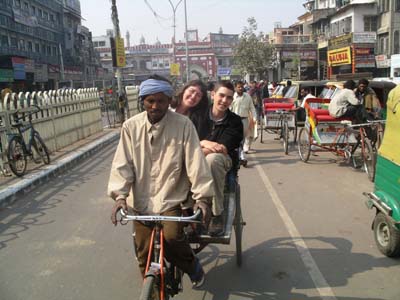 tantly
pushing through. More than once we found ourselves stuck in an intersection
or pinned up against a wall as traffic squeezed by. Utpal's reassurances were
helpful, and we simply followed him as cautiously as possible and tried to
stay close.
tantly
pushing through. More than once we found ourselves stuck in an intersection
or pinned up against a wall as traffic squeezed by. Utpal's reassurances were
helpful, and we simply followed him as cautiously as possible and tried to
stay close.
After exploring some of Old Delhi's streets by foot, Utpal flagged down 3
rickshaws and arranged for us to take a ride through the Chandni Chowk, Old
Delhi's main street and a famous shopping bazaar. After overcoming our initial
fear of riding unsteadily on the back of these rickety 3-wheelers (and also
the risk of somehow 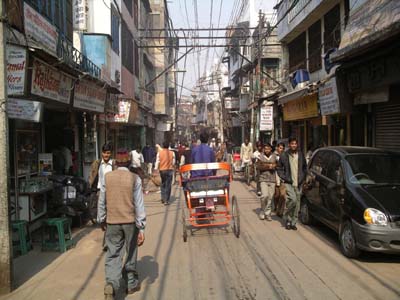 becoming
separated), we tried to absorb everything that was going on around us. The
rickshaws are everywhere, and really seem to clog things up (largely because
of their width). The number of people who are traveling this street at any
time is unbelievable. There are traffic lights at the intersections, but none
were working and everyone simply pushed their way through. Horns blare constantly,
often telling
becoming
separated), we tried to absorb everything that was going on around us. The
rickshaws are everywhere, and really seem to clog things up (largely because
of their width). The number of people who are traveling this street at any
time is unbelievable. There are traffic lights at the intersections, but none
were working and everyone simply pushed their way through. Horns blare constantly,
often telling 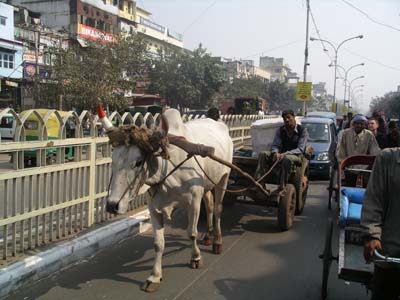 pedestrians
or slower cycles to move or be hit. Amazingly, we didn't see any accidents
today. However, Paula did get brushed twice - once by a rickshaw and another
time by a large crate being carried by someone on their head. All part of
a day on the streets of Delhi, we guess…
pedestrians
or slower cycles to move or be hit. Amazingly, we didn't see any accidents
today. However, Paula did get brushed twice - once by a rickshaw and another
time by a large crate being carried by someone on their head. All part of
a day on the streets of Delhi, we guess…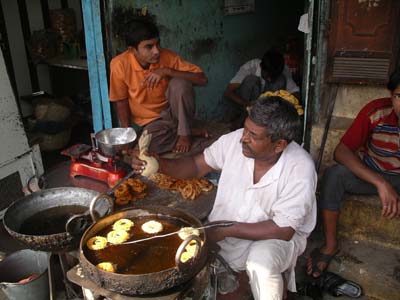
Chandni Chowk is lined with shops, street vendors, craftsmen working right
on the sidewalk, beggars, touts, and many who seemed to be aimlessly hanging
around. We were struck by the number of women and children who approached
or followed us asking for money. This began as soon as we left our minibus
for the first time. The begging here is much more prevalent than any place
we've seen, and the people 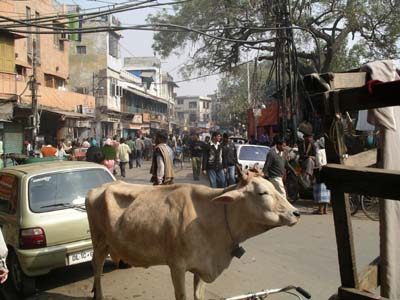 asking
for money are extremely persistent. Sometimes, the beggars come right up to
cars and go from window to window trying to get attention. While we were walking,
they sometimes wouldn't leave us alone until Utpal spoke to them firmly in
Hindi.
asking
for money are extremely persistent. Sometimes, the beggars come right up to
cars and go from window to window trying to get attention. While we were walking,
they sometimes wouldn't leave us alone until Utpal spoke to them firmly in
Hindi.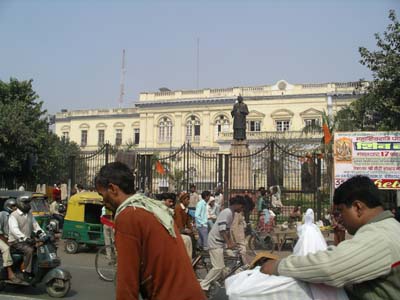
After the rickshaw ride, Utpal took us for a fascinating tour of Gurdwara
Sis Ganj Sahib, a Sikh complex located directly on Chandni Chowk. As seems
like it will frequently be the case here in India, we really had no idea of
what we were in for. Uptal said he wanted us to see the "Real India."
We started by meeting two Sikhs who asked us to remove our shoes and socks,
and then covered our heads with yellow cloths. After a brief discussion of
Sikhism and overview of 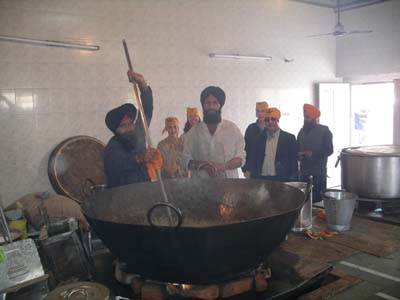 what
we were about to see, we headed into the complex, walking over water that
had been sprayed in the entryway. The water is considered to be holy, and
is used to wash your feet. As we walked into the complex (along with many
who were praying and splashing themselves with the water), we entered a large
prayer hall. In the front, three men were chanting and playing Sikh music,
and another was sitting with their holy book that was kept under a colorful
blanket. The room was filled with all sorts of people engaged in what appeared
to be different types of prayers.
what
we were about to see, we headed into the complex, walking over water that
had been sprayed in the entryway. The water is considered to be holy, and
is used to wash your feet. As we walked into the complex (along with many
who were praying and splashing themselves with the water), we entered a large
prayer hall. In the front, three men were chanting and playing Sikh music,
and another was sitting with their holy book that was kept under a colorful
blanket. The room was filled with all sorts of people engaged in what appeared
to be different types of prayers.
We then walked into the area where food is prepared and served. 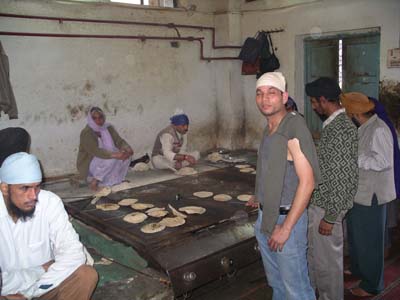 Each
day, this complex feeds 10,000 people who come from Delhi and all over India.
Many are Sikhs, but we saw several people of other religions. The kitchens
are staffed by volunteers, and we were encouraged to take pictures of the
food being prepared. The food, primarily bread and sweet pudding, is all provided
free. We saw large numbers of people waiting for their meal, and Uptal told
us that many were not here due to poverty, but for what they consider to be
a holy experience.
Each
day, this complex feeds 10,000 people who come from Delhi and all over India.
Many are Sikhs, but we saw several people of other religions. The kitchens
are staffed by volunteers, and we were encouraged to take pictures of the
food being prepared. The food, primarily bread and sweet pudding, is all provided
free. We saw large numbers of people waiting for their meal, and Uptal told
us that many were not here due to poverty, but for what they consider to be
a holy experience.
As we walked through the Sikh complex, much of what was going through each
of our minds was something like "I can't believe we're here." We
saw no other Westerners inside. However, as strange (and admittedly somewhat
uncomfortable) as it felt to be there, with our covered heads and bare feet
(you can see Paula, David and Katie in the background of the picture above
with the large pot), we did not feel unwelcome. Some people smiled at us and
invited us to take pictures. Most went on with their prayers and other activities,
as if we weren't there at all. 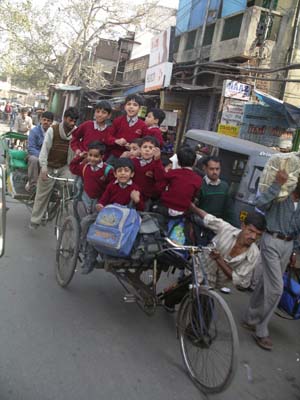

Leaving Old Delhi, we saw many uniformed children who were just getting out of school for the day. It was cute to see them huddled together on rickshaws that served as school buses. As we crept along the crowded streets, many of these children waved and smiled at us through our windows, and we were able to get a few pictures.
We left Old Delhi and drove to the Gandhi museum and memorial, a short distance
away. The museum was extremely interesting, yet understated and very simple
(as Gandhi would have wanted it). It follows his life chronologically with
a series of pictures and explanatory plaques. The museum contains many of
his personal belongings, including the blood-stained clothes and other items
from his final day. Everything is 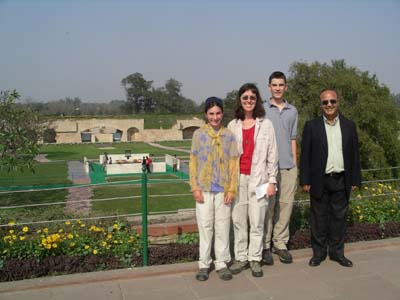 housed
in very basic display cases. There is no charge for admission (only a request
for small donations). We saw very few people inside, and we were certainly
the only Westerners there today.
housed
in very basic display cases. There is no charge for admission (only a request
for small donations). We saw very few people inside, and we were certainly
the only Westerners there today.
Outside the museum is the Gandhi Memorial, sitting on the site where his
body was cremated shortly after his assassination in January 1948. This is
a large, open and very green area and is visited by over 50,000 people every
day. Today we saw a steady stream of people from a variety of religions (Utpal
can tell us the religion and often the home of every person we see) paying
their respects. Many world leaders have come here, and we were told that President
Clinton visited in 2000.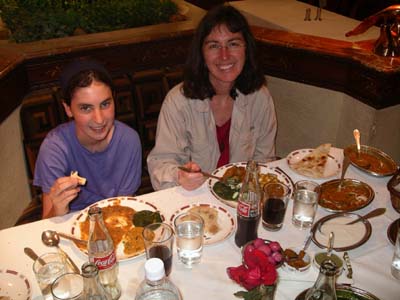
It was now after 3:00, and we were all very hungry. Utpal took us to one of his favorite restaurants in Delhi, knowing that the lunch rush was over and we could be seated immediately. After being seated, Utpal asked if we would trust him to order for the table, and we readily agreed (this brought back memories of this exact situation in Istanbul and the wonderful lunch we had with our guide Ali). Lunch was a tasty (and not too spicy) combination of mutton, lentils, cheese cooked with spinach, rice and wonderfully prepared breads. Other than last night, this was really our first Indian meal and despite our initial apprehension we enjoyed all our food. David literally cleaned his plate, wiping it with the delicious bread.
We realize that mutton will be the main (only?) type of meat we'll eat here. Obviously, beef is not served (except in some 5-star hotels), Katie doesn't eat lamb, and we've decided to not eat chicken (because of the Asian bird flu). So mutton it is!
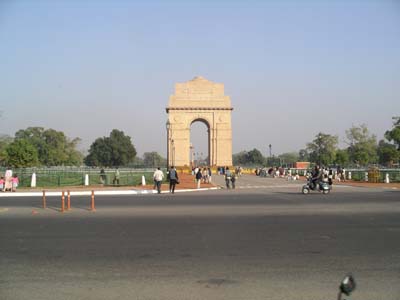 After
lunch we took a drive through the government center area of Delhi, seeing
the Indian War Memorial, the parliament building, and the President's House.
Utpal told us that 10 years ago he was a neighbor (here in Delhi) of the current
President. Utpal and his son have had a couple of occasions to meet the President,
and he enjoyed telling us the stories around these encounters.
After
lunch we took a drive through the government center area of Delhi, seeing
the Indian War Memorial, the parliament building, and the President's House.
Utpal told us that 10 years ago he was a neighbor (here in Delhi) of the current
President. Utpal and his son have had a couple of occasions to meet the President,
and he enjoyed telling us the stories around these encounters.
Our final stop was at the Lotus Temple, a Bahai house of worship that is
shaped like a lotus flower. It's a new building and set in the middle of a
group of pools and gardens. Interestingly, this is where we saw the greatest
number of tourists all day. However, almost all the visitors were Indian,
displaying a wide variety of colorful dress and face markings. As people walked
by, Utpal told us where 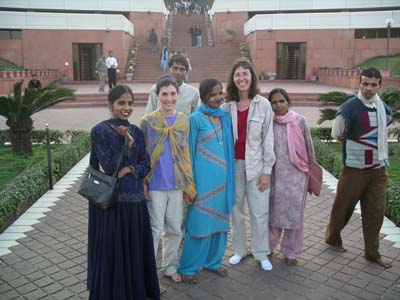 each
group was from based on their appearance and language. Several times he asked
people where they lived in order to confirm his guess, and we were impressed
to find that each time he was right.
each
group was from based on their appearance and language. Several times he asked
people where they lived in order to confirm his guess, and we were impressed
to find that each time he was right.
We were amused when one group of colorfully-dressed women actually asked us if they could have their picture taken with Paula and Katie. We said yes, as long as we could also take a picture! The attitude of the Indian people toward picture-taking is totally different from what we saw in Morocco, Russia or Istanbul (the only other non-Western countries we've been to so far). In these places, most people did not want to be photographed (with some agreeing only if they were paid). Here, it's just the opposite.
For all the pictures we've seen and what we have read about India and daily
life on the streets, nothing could replicate the strikingly vivid and permanent
image that today's activities in Delhi has created. We keep reminding ourselves
that 1 billion people - fully 1/6 of the world's population - live in India.
Only about 25% live in the cities, so we're looking forward to our upcoming
visits to some of India's rural villages where we can get a sense for how
most people in this huge country live.
Tomorrow morning we leave Delhi and our next stop will be Agra, site of the Taj Mahal. We also plan on stopping at several villages along the way.
Katie's Kwick Kwacks: Our Visit to a Sikh Temple. Today we visited a very interesting Sikh Temple. Sikhs are people who practice the religion of Sikhism. There are about eighteen million Sikh people in India, and mostly live in a city called Punjab. Sikh people always have their heads covered, so we had to put on bandanas and take off our shoes and socks. When we approached the temple, we noticed that the marble steps in front of it were very wet. We also saw people taking a little of the water on their hands, and putting it on certain spots of their face. We learned that they do this in hopes of picking up a little dirt to show they are humble before entering their holy place of worship.
As we entered the temple, we immediately heard music. The main altar had a small canopy with a man in the middle of it. He was kneeling behind a blanket with many flowers on it. We learned that underneath the blanket were the Sikh's holy books. Beside the main altar were three men chanting prayers and playing music. After making a small donation to the temple, we went into the courtyard of the complex. Here we entered a room with two men fixing pudding in an enormous pot. It smelled wonderful! We learned that the Sikh complex serves free food to people of all religions and backgrounds - about 10,000 people a day! We also learned that they have a guest house, open for people to sleep in the complex any time they want. After learning about how they organize this cafeteria, we went into a basement where we saw many volunteer women kneading dough, and men frying the dough. It was a fascinating sight. In the next section of the basement we saw many people waiting in line for their food. It was wonderful to see how welcoming the complex was to all kinds of people.
As you can see, this was a wonderful experience for us, and we look forward to learning more about India's many religious groups during our stay in this fascinating country.
David's Daily Dump: Our Rickshaw Ride in Delhi. Our exciting and frightening rickshaw ride through Delhi was one of the more adventurous things that we did yesterday. Rickshaws are old rusty bikes with a bench on the back meant for two people. They roam the streets carrying people from here to there and maneuver through cars, pedestrians, motorcycles, and bull carts on the busy streets. At first site they look dangerous and as if they will fall apart at any moment, but we soon learned that it is much safer to ride in one than to walk!
As I climbed aboard our old rickshaw with Mom I was a little frightened. I realized that we were going to ride on these bikes through the city trusting the driver to not let us get hit buy cars or run over by huge bulls! Not to mention that there are no handles. I was hanging on to Mom for dear life! Well, not exactly for dear life, but it sure seemed like it at the time. While we were riding, I realized that being on the rickshaw was actually safer than walking. It's one less thing that you can get hit by on the road! After we started I began to fell more comfortable and had fun trying to keep up with the rickshaw that Dad and Katie were on. Everyone was very friendly with us and always greeted us while we rode past them. One of the drivers of a bull cart even made his bull run to show us he was faster than us.
Like most crazy things we do, it seems scary at first, but in the end we have a great time and can call ourselves "adventurous."
